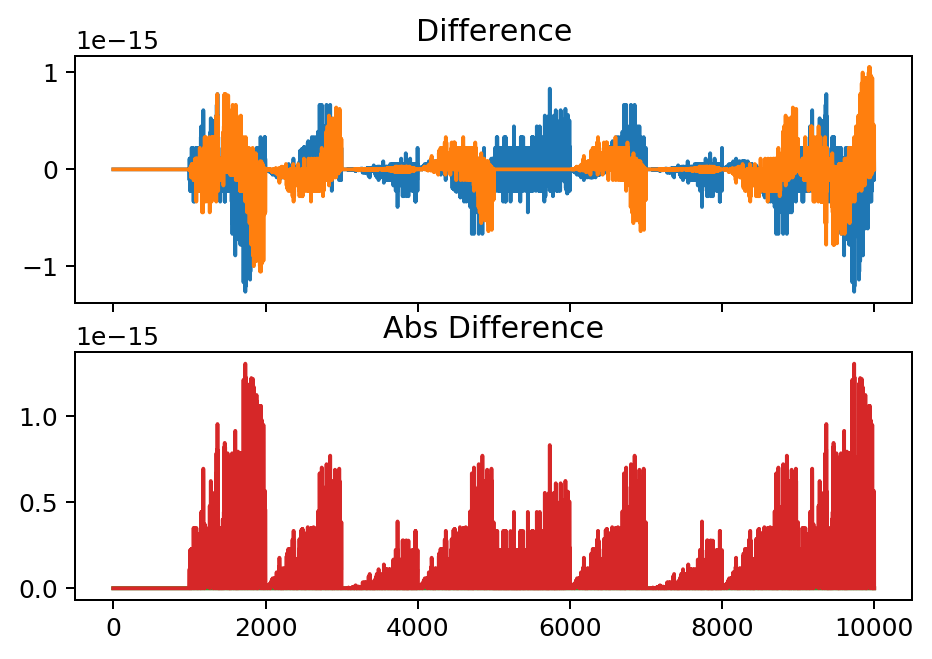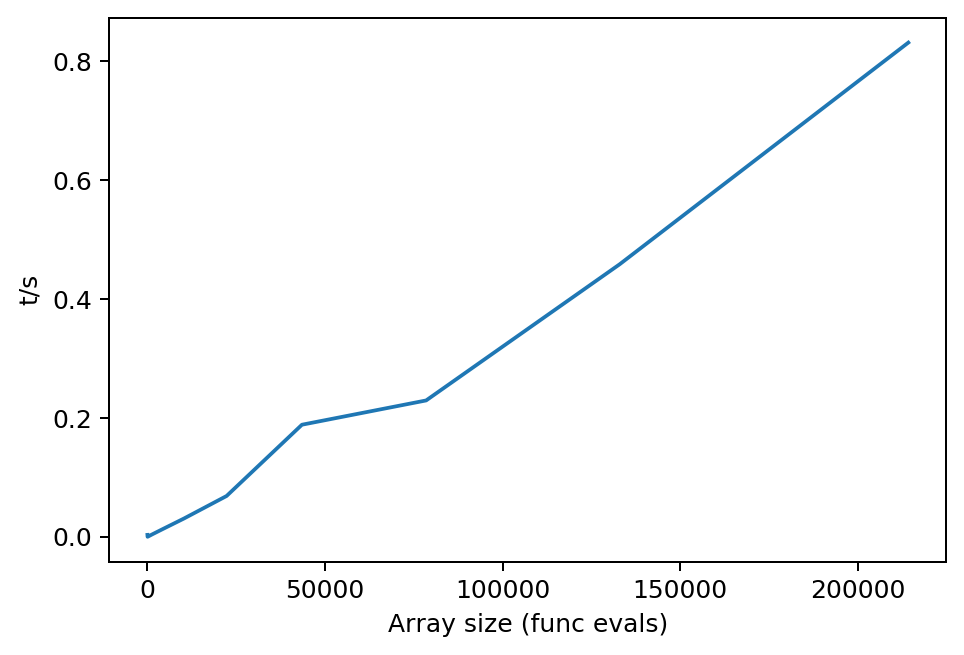ePSproc function defn tests
13/08/19
Wigner D
Compare existing ePSproc_wignerD.m (Matlab, matches Zare defn.) to Moble’s quaternion-based version (matches Wikipedia defn.).
Defns….
See:
Moble’s notes:
Summary: - Moble’s WignerD defn. matches wikipedia. - Euler angle defns. also consistent, \((\alpha, \beta, \gamma) \equiv (\phi, \theta, \chi)\). - Zare defns, eqns. 3.54-3.55, as used in ePSproc, is conjugate form (as compared to wiki defn.). - Python calcs should match Matlab conj(ePSproc_wignerD.m), either defined numreically or via algebraic defn. - Python calcs ~2 orders of magnitude faster than (admittedly unoptimized) Matlab ePSproc codes.^
^ Benchmarks run on a Threadripper 1950X machine. The python calcs. barely troubled one core; the Matlab calcs were highly inefficient (lots of loops) and used ~30 - 50% of a single core… for much longer. On an Atom-based cheap laptop the python numbers were still ~1 order of magnitude faster. See below for details.
Basic test
[1]:
# Imports
import numpy as np
import spherical_functions as sf
import quaternion
import matplotlib.pyplot as plt
[2]:
#%% Basic test with Euler angles
alpha, beta, gamma = 0.1, 0.2, 0.3
ell,mp,m = 3,2,1
wD_euler = sf.Wigner_D_element(alpha, beta, gamma, ell, mp, m)
print(wD_euler)
(-0.2647616388657892-0.14463994252750317j)
[3]:
#%% With quaternion
R = np.quaternion(1,2,3,4).normalized()
wD_quat = sf.Wigner_D_element(R, ell, mp, m)
print(wD_quat)
(-0.25825267558041726-0.0653537383101466j)
[4]:
#%% With quaternion defined by Euler angles
R_euler = quaternion.from_euler_angles(alpha, beta, gamma)
wD_eQuat = sf.Wigner_D_element(R_euler, ell, mp, m)
print(wD_eQuat)
# Check
print(wD_eQuat - wD_euler)
(-0.2647616388657892-0.14463994252750317j)
0j
Benchmark vs ePSproc_wignerD.m (Matlab)
[5]:
#%% WignerD bench
# Adapted directly from Matlab code
# Set QNs for calculation, (l,m,mp)
Lmax = 6
QNs = []
for l in np.arange(0, Lmax+1):
for m in np.arange(-l, l+1):
for mp in np.arange(-l, l+1):
QNs.append([l, m, mp])
QNs = np.array(QNs)
# Set a range of Eugler angles for testing
Nangs = 1000
pRot = np.linspace(0,180,Nangs)
tRot = np.linspace(0,90,Nangs)
cRot = np.linspace(0,180,Nangs)
eAngs = np.array([pRot, tRot, cRot,])*np.pi/180
# Convert to quaternions
R = quaternion.from_euler_angles(pRot*np.pi/180, tRot*np.pi/180, cRot*np.pi/180)
#****** wignerD vectorised for QN OR angles
wD_QNs = []
for n in np.arange(0, QNs.shape[0]):
wD_QNs.append([QNs[n,:], R, sf.Wigner_D_element(R, QNs[n,0], QNs[n,1], QNs[n,2])])
[6]:
#%% Compare with Matlab results
from scipy.io import loadmat
x = loadmat(r'wignerD_bench_090819.mat')
wD_QNsMatlab = x['wD_QNs']
def wD_sortf(wD_QNs, conjPy = True):
# Sort to array for comparison
wD_sort=[]
if conjPy:
# With conjugate on Python results
[wD_sort.extend(np.c_[np.tile(wD[0],(wD[2].shape[0],1)), wD[2].conj()]) for wD in wD_QNs]
else:
# For QN looped case
[wD_sort.extend(np.c_[np.tile(wD[0],(wD[2].shape[0],1)), wD[2]]) for wD in wD_QNs]
# For angle looped case
# [wD_sort.extend(np.c_[wD[0], wD[2]]) for wD in wD_QNs]
return np.asarray(wD_sort)
[7]:
conjFlag = True
wD_sort = wD_sortf(wD_QNs, conjPy = conjFlag)
# Subtract and plot
wD_test = wD_sort - wD_QNsMatlab[:,0:4]
# Set plot params
pRange = np.arange(1,10000)
sPlots = 4
colPlot = 3 # Set as index into python results
fig, ax = plt.subplots(2, 1, sharex='col', dpi=180)
ax[0].plot(np.c_[np.real(wD_sort[pRange,colPlot]), np.imag(wD_sort[pRange,colPlot])])
ax[0].set_title('Moble (Wikipedia) Wigner D, conjFlag = ' + str(conjFlag))
ax[1].plot(np.c_[np.real(wD_QNsMatlab[pRange,colPlot]), np.imag(wD_QNsMatlab[pRange,colPlot])])
ax[1].set_title('ePSproc (Zare) Wigner D')
fig, ax = plt.subplots(2, 1, sharex='col', dpi=180)
ax[0].plot(np.c_[np.real(wD_test[pRange,colPlot]), np.imag(wD_test[pRange,colPlot])])
ax[0].set_title('Difference')
#plt.subplot(sPlots,1,4)
ax[1].plot(np.abs(wD_test[pRange,:]))
ax[1].set_title('Abs Difference')
plt.show()
# Check values
wD_test.max()


[7]:
(4.773959005888173e-15+8.326672684688674e-16j)
> For conjugate version, differences on order of 1e-15. OK.
Timings
Timings pretty consistent for list comp vs. loop.
[8]:
# Try timing as wall clock for more flexibility...
# https://www.techbeamers.com/python-time-functions-usage-examples/
# Get similar results for time.time(), time.clock() and time.perf_counter()
import time
tS = time.perf_counter()
tBench = []
fEvals = []
# Set QNs for calculation, (l,m,mp)
for Lmax in np.arange(0,11):
QNs = []
for l in np.arange(0, Lmax+1):
for m in np.arange(-l, l+1):
for mp in np.arange(-l, l+1):
QNs.append([l, m, mp])
QNs = np.array(QNs)
tQN = time.perf_counter()
#****** wignerD vectorised for QN OR angles
wD_QNs = []
for n in np.arange(0, QNs.shape[0]):
wD_QNs.append([QNs[n,:], R, sf.Wigner_D_element(R, QNs[n,0], QNs[n,1], QNs[n,2])])
tLoop = time.perf_counter()
wD_QNs = []
[wD_QNs.append([QN, R, sf.Wigner_D_element(R, QN[0], QN[1], QN[2])]) for QN in QNs]
tBench.append([tQN, tLoop, time.perf_counter()])
fEvals.append([Lmax, len(wD_QNs)*len(R)])
tBench = np.asarray(tBench)
tDeltas = np.c_[tBench[:,1]-tBench[:,0], tBench[:,2]-tBench[:,1]]
# print(tDeltas)
# Plot
fEvals = np.asarray(fEvals)
plt.figure(dpi = 180)
plt.plot(fEvals[:,1], tDeltas)
plt.xlabel('Array size (func evals)')
plt.ylabel('t/s')
plt.show()

> Compare with Matlab code - massively faster…
(Benchmarks on a Threadripper 1950X machine. On an Atom-based cheap laptop the python numbers here topped out at 1.4s, so were still massively faster (Matlab benchmarks were not tested on that machine).)
[9]:
# Compare with Matlab benchmarks (not even funny...!)
x = loadmat(r'wignerD_bench_t_090819.mat')
wDBenchMatlab = x['wDbench']
plt.figure(dpi = 180)
# plt.plot(fEvals[:,1],np.c_[tDeltas[:,0], wDBenchMatlab[1:,3]])
plt.plot(fEvals[:,1], tDeltas[:,0])
plt.plot(wDBenchMatlab[1:,2], wDBenchMatlab[1:,3])
plt.xlabel('Array size (func evals)')
plt.ylabel('t/s')
plt.show()
print('Check fEvals for consistency:')
print(wDBenchMatlab[1:,2] - fEvals[:,1])

Check fEvals for consistency:
[ 0. 9. 34. 83. 164. 285. 454. 679. 968. 1329. 1770.]
Note slight difference in overall fn. evals (probably an extraneous extra loop in Matlab code), but won’t make a significant difference here.
Wigner 3j
Should be consistent… - Moble’s functions based on Sympy. - Sympy matches Zare defn. - ePSproc matches Zare defn.
Basic test
[10]:
#%% Basic tests
# See https://github.com/moble/spherical_functions/blob/master/Wigner3j.py
# Syntax Wigner3j(j_1, j_2, j_3, m_1, m_2, m_3)
# Integer values only, and single values only?
print(sf.Wigner3j(2, 6, 4, 0, 0, 0))
print(sf.Wigner3j(2, 6, 4, 0, 0, 1))
0.18698939800169143
0.0
Benchmark vs. ePSproc_3j.m (Matlab, Zare defns.)
[11]:
#%% Test set of values
Lmax = 6
QNs = []
for l in np.arange(0, Lmax+1):
for lp in np.arange(0, Lmax+1):
for m in np.arange(-l, l+1):
for mp in np.arange(-lp, lp+1):
for L in np.arange(0, l+lp+1):
M = -(m+mp)
QNs.append([l, lp, L, m, mp, M])
QNs = np.array(QNs)
# Test vector compatibility - NOPE... but pretty fast anyway
# test = sf.Wigner3j(QNs[:,0], QNs[:,1], QNs[:,2], QNs[:,3], QNs[:,4], QNs[:,5])
# LOOP OVER QNs and calculate
w3j_QNs = []
for n in np.arange(0, QNs.shape[0]):
w3j_QNs.append([QNs[n,:], sf.Wigner3j(QNs[n,0], QNs[n,1], QNs[n,2], QNs[n,3], QNs[n,4], QNs[n,5])])
[12]:
#%% Test vs. Matlab reference
from scipy.io import loadmat
x = loadmat(r'wigner3j_bench_L6_130819.mat')
w3j_QNsMatlab = x['QNs_3j']
# Sort to array for comparison - WORKS, but UGLY. Should be a better way?
w3j_sort=[]
[w3j_sort.append(np.r_[wD[0], wD[1]]) for wD in w3j_QNs]
w3j_sort = np.array(w3j_sort)
# Subtract and plot
w3j_test = w3j_sort - w3j_QNsMatlab[:,0:7]
# Set plot params
pRange = np.arange(1,1000)
sPlots = 3
colPlot = 6 # Set as index into python results
fig, ax = plt.subplots(sPlots, 1, sharex='col', dpi=180)
ax[0].plot(w3j_sort[pRange,colPlot])
ax[0].set_title('Moble (Wikipedia) Wigner 3j')
ax[1].plot(w3j_QNsMatlab[pRange,colPlot])
ax[1].set_title('ePSproc (Zare) Wigner 3j')
ax[2].plot(w3j_test[pRange,colPlot])
ax[2].set_title('Difference')
# plt.subplot(sPlots,1,4)
# plt.plot(np.abs(w3j_test))
# plt.title('Abs Difference')
plt.show()
# Check values
wD_test.max()

[12]:
(4.773959005888173e-15+8.326672684688674e-16j)
> Differences on order 1e-16. OK.
Timings
[13]:
# Try timing as wall clock for more flexibility...
# https://www.techbeamers.com/python-time-functions-usage-examples/
# Get similar results for time.time(), time.clock() and time.perf_counter()
import time
tS = time.perf_counter()
tBench = []
fEvals = []
# Set QNs for calculation, (l,m,mp)
for Lmax in np.arange(0,11):
QNs = []
for l in np.arange(0, Lmax+1):
for lp in np.arange(0, Lmax+1):
for m in np.arange(-l, l+1):
for mp in np.arange(-lp, lp+1):
for L in np.arange(0, l+lp+1):
M = -(m+mp)
QNs.append([l, lp, L, m, mp, M])
QNs = np.array(QNs)
tQN = time.perf_counter()
#****** LOOP OVER QNs and calculate
w3j_QNs = []
for n in np.arange(0, QNs.shape[0]):
w3j_QNs.append([QNs[n,:], sf.Wigner3j(QNs[n,0], QNs[n,1], QNs[n,2], QNs[n,3], QNs[n,4], QNs[n,5])])
tLoop = time.perf_counter()
tBench.append([tQN, tLoop])
fEvals.append([Lmax, len(QNs)])
tBench = np.asarray(tBench)
# print(tBench)
tDeltas = np.c_[tBench[:,1]-tBench[:,0]]
# print(tDeltas)
# Plot
fEvals = np.asarray(fEvals)
plt.figure(dpi = 180)
plt.plot(fEvals[:,1], tDeltas)
plt.xlabel('Array size (func evals)')
plt.ylabel('t/s')
plt.show()

> Compare with Matlab code - massively faster…
[14]:
# Compare with Matlab benchmarks (not even funny...!)
x = loadmat(r'wigner3j_bench_t_090819.mat')
w3jBenchMatlab = x['w3jbench']
plt.figure(dpi = 180)
plt.plot(fEvals[:,1], tDeltas)
plt.plot(w3jBenchMatlab[1:,1], w3jBenchMatlab[1:,2])
plt.xlabel('Array size')
plt.ylabel('t/s')
plt.show()
print('Check fEvals for consistency:')
print(w3jBenchMatlab[1:,1] - fEvals[:,1])

Check fEvals for consistency:
[ 0. -12. -42. -98. -188. -320. -502. -742. -1048. -1428.
-1890.]
Note slight difference in overall fn. evals (probably an extraneous extra loop in Matlab code), but won’t make a significant difference here.